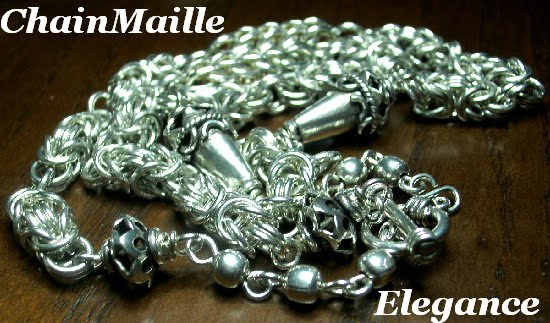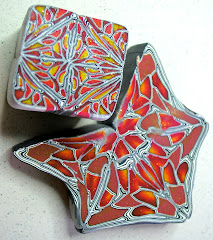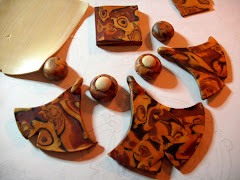 | |
| Unfinished clay, no sanding or buffing. |
 |
| Same cabochon, sanded and buffed! |
And the more you buff the more detail comes out. Also if you add heat to the surface, ( I use a blow dryer on high) and get it really close to the clay, it makes the translucent more transparent, adding even more depth and removing any cloudy areas!
 |
| Chainmialle... lace finishing touches, but not yet sanded or buffed. |
The depth in these pieces is achieved by mixing the clays with 50% translucent clay before mica shift, then skinner blend the clays together, stacking them and slicing in the diagonal. However, without sanding and buffing these pieces, or applying heat, they would be simply flat looking pieces of clay. It is all in the finishing touches with polymer clay, you could do all the blending and mica shifting you want, but if you are not going to apply these finishing touches, your blending and mica shift won't show up as much!
Take a little time to try these finishing touches and see the difference in your work, I am enjoying the tangibility of my polymer clay pieces now and do not stop shy of finishing every piece. Never make a jugement about your piece until it is completely finished, it will come to life if you give it a chance! Look at the pic's of the same cabochon, before and after finishing touches, it is amazing!
 |
| Sanded but not yet buffed, they will be shined up nicely! |
Remember to always create, and take time to finish each piece!






Very pretty. I love how buffing or a gloss finish can bring out the color and depth of the clay.
ReplyDeleteEFO, thanks for commenting! I just wanted to add, that gloss does not bring out detail, it only intensifies the colors. It will not ad the needed friction to and heat related to enhancing the texture and depth. Only sanding and buffing, bring out the layering and enhances the techniques used to create your masterpiece!
ReplyDeleteIn my opinion...
Gloss is fine for small beads that can not be sanded, but sanding and buffing should be done for all loafs and cane work, to bring out the pattern and texture not to mention dimension and bring out the clarity of the translucent clay.